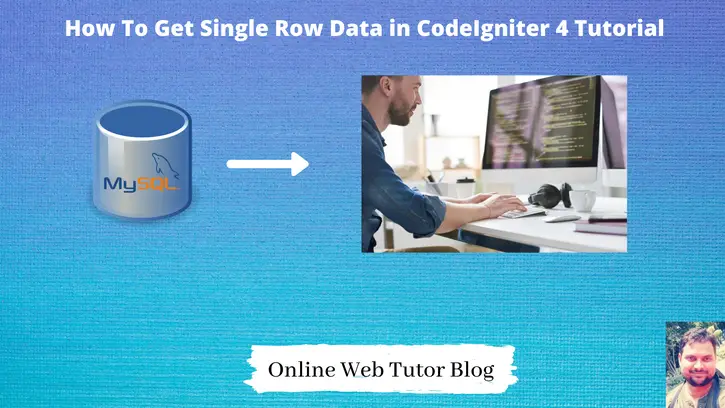In web development, retrieving a single row of data from a database is a common requirement for various application scenarios. In CodeIgniter 4, fetching a single record efficiently enables developers to access specific data entries, allowing targeted data manipulation and utilization.
In this tutorial, we’ll see the comprehensive process of fetching a single row of data from a database using CodeIgniter 4. This functionality empowers developers to retrieve specific records based on criteria.
There are several methods available to get single row data like using Models, using Query Builder, using Raw Queries.
Read More: CodeIgniter 4 How To Read Parse CSV File Tutorial
Let’s get started.
CodeIgniter 4 Installation
To create a CodeIgniter 4 setup run this given command into your shell or terminal. Please make sure composer should be installed.
composer create-project codeigniter4/appstarter codeigniter-4Assuming you have successfully installed application into your local system.
Environment (.env) Setup
When we install CodeIgniter 4, we will have env file at root. To use the environment variables means using variables at global scope we need to do env to .env
Either we can do via renaming file as simple as that. Also we can do by terminal command.
Open project in terminal
cp env .envAbove command will create a copy of env file to .env file. Now we are ready to use environment variables.
Enable Development Mode
CodeIgniter starts up in production mode by default. You need to make it in development mode to see any error if you are working with application.
Open .env file from root.
# CI_ENVIRONMENT = production
// Do it to
CI_ENVIRONMENT = developmentNow application is in development mode.
Database Connection
Open .env file from project root.
Search for DATABASE. You should see the connection environment variables into it. Put your updated details of database connection string values.
#-------------------------------------------------------------------- # DATABASE #-------------------------------------------------------------------- database.default.hostname = localhost database.default.database = codeigniter4_app database.default.username = admin database.default.password = admin database.default.DBDriver = MySQLi database.default.DBPrefix = database.default.port = 3306
Now, database successfully connected with the application.
Read More: CodeIgniter 4 How To Integrate Ckeditor Example Tutorial
Idea #1 – Working with Raw Queries
Suppose you have any controller and used raw query to get single row data.
Here, we have considered several cases to get single row
- Single Row Data (Object Format)
- Single Row Data in Array Format
- First Single Row
- Last Single Row
<?php
namespace App\Controllers;
class Site extends BaseController
{
private $db;
public function __construct()
{
$this->db = db_connect();
}
// get single row
public function getUsers()
{
$query = $this->db->query("SELECT * from users");
echo "<pre>";
print_r($query->getRow());
}
}
Single row result in Object format
// get single row
public function getUsers()
{
$query = $this->db->query("SELECT * from users");
echo "<pre>";
print_r($query->getRow()); // OR print_r($query->getRowObject());
}Single row result in Array format
// get single row
public function getUsers()
{
$query = $this->db->query("SELECT * from users");
echo "<pre>";
print_r($query->getRowArray());
}First row from table
// get single row
public function getUsers()
{
$query = $this->db->query("SELECT * from users");
echo "<pre>";
print_r($query->getFirstRow());
}Last row from table
// get single row
public function getUsers()
{
$query = $this->db->query("SELECT * from users");
echo "<pre>";
print_r($query->getLastRow());
}Read More: How to Use CodeIgniter Components Example Tutorial
Idea #2 – Working with Query Builder
Suppose you have any controller and used query builder concept to get single row data.
<?php
namespace App\Controllers;
class Site extends BaseController
{
private $db;
public function __construct()
{
$this->db = db_connect();
}
public function getUsers()
{
$usersTable = $this->db->table("users");
$usersTable->select("name, email");
$query = $usersTable->get();
echo "<pre>";
print_r($query->getRow());
}
}
Single row in object format
public function getUsers()
{
$usersTable = $this->db->table("users");
$usersTable->select("name, email");
$query = $usersTable->get();
echo "<pre>";
print_r($query->getRow());
}We can use the same methods what we used inside raw queries.
- Single Row Data (Object Format) – $query->getRow() / $query->getRowObject()
- Single Row Data in Array Format – $query->getRowArray()
- First Single Row – $query->getFirstRow()
- Last Single Row – $query->getLastRow()
Idea #3 – Working with Model
Suppose you have any controller and used model concept to get single row data.
<?php
namespace App\Controllers;
use App\Models\UserModel;
class Site extends BaseController
{
public function getUsers()
{
$userObject = new UserModel();
$data = $userObject->first();
echo "<pre>";
print_r($data);
}
}
Single row data in Array format
public function getUsers()
{
$userObject = new UserModel();
$data = $userObject->first();
echo "<pre>";
print_r($data);
}Read More: CodeIgniter 4 Autocomplete Places Search Using Google Maps JavaScript API
Get Last row data in Array format
public function getUsers()
{
$userObject = new UserModel();
$data = $userObject->orderBy("id", "desc")->first();
echo "<pre>";
print_r($data);
}That’s it.
We hope this article helped you to How To Get Single Row Data in CodeIgniter 4 Tutorial in a very detailed way.
Online Web Tutor invites you to try Skillshike! Learn CakePHP, Laravel, CodeIgniter, Node Js, MySQL, Authentication, RESTful Web Services, etc into a depth level. Master the Coding Skills to Become an Expert in PHP Web Development. So, Search your favourite course and enroll now.
If you liked this article, then please subscribe to our YouTube Channel for PHP & it’s framework, WordPress, Node Js video tutorials. You can also find us on Twitter and Facebook.
